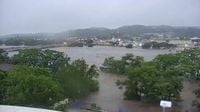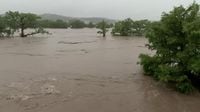On the morning of July 4, 2025, catastrophic flooding devastated communities along the Guadalupe River in Texas' Hill Country, leading to multiple fatalities and widespread destruction. Heavy overnight rains unleashed a torrent that overwhelmed the river, pushing it to its second-highest level on record near Hunt, surpassing historic floods from 1987. The floodwaters swept through Kerr County and surrounding areas, forcing urgent evacuations, stranding residents, and causing severe damage to homes, roads, and local businesses.
The Guadalupe River surged past 29 feet, a level not seen in nearly four decades, after receiving between 5 and 11 inches of rain overnight, with some spots recording nearly 10 inches. The National Weather Service (NWS) issued a flash flood emergency for South-Central Kerr County, warning of a life-threatening event that would continue through the afternoon as additional rain fell. Radar showed heavy precipitation lingering over Medina, Bandera, Kerr, Kendall, and Gillespie counties, with 2 to 5 more inches possible before conditions improved.
Kerr County Judge Rob Kelly described the situation as "very devastating and deadly," confirming at least six deaths, though he cautioned that the toll could rise. Kelly declined to release precise numbers of the deceased or missing, citing ongoing efforts to notify next of kin. "We have some numbers, but we’re not going to use them at this time," he said during a news conference. Officials have conducted "dozens" of water rescues amid the flooding, with emergency crews working tirelessly to reach those trapped by the rising waters.
Among the most harrowing stories emerged from Camp Mystic, a Christian summer camp for girls located in Hunt near the Guadalupe River. Directors Britt and Catie Eastland urgently pleaded for air assistance as roads were washed out, complicating rescue efforts. Some children remain unaccounted for, and several cabins were reportedly flooded or even swept away by the floodwaters. An email obtained by local media confirmed that parents of missing campers had been notified, though Kerr County Judge Kelly advised that parents reach out to camps directly for the latest information.
The flood struck in the early hours of July 4, catching many residents off guard. Lorena Guillen, owner of Howdy’s Restaurant in Kerrville, recounted noticing heavy rain around 2:30 a.m., only to witness the flash flood surge within an hour. "By then, it was too late for the campers," she said. Every RV at the nearby park was swept away, and the restaurant itself suffered damage, losing running water and having its propane tank carried off by the flood. Guillen estimated the water rose by about 40 feet, describing the scene as "total devastation" with helicopters rescuing people stranded in trees.
Despite the area’s history of flooding, Kerr County lacks a warning system for the Guadalupe River. Judge Kelly explained, "Rest assured, no one knew this flood was coming. This is the most dangerous river valley in the United States. We deal with floods on a regular basis. When it rains, we have water. We had no reason to believe this was going to be anything like what happened here, none whatsoever." A flash flood watch had been issued on the afternoon of July 3, with the first flood warning arriving at 1 a.m. on July 4, but the scale of the disaster was unexpected.
Residents living near the Guadalupe River and other waterways were urged to evacuate to higher ground immediately, while others were advised to shelter in place and avoid travel. Roads in the region, including Highway 27 at Cypress Creek and FM 1350 east of Center Point, were closed due to flooding. The Boerne Fire Department deployed rescue teams to assist residents in Kendall County, where significant flooding also affected communities like Comfort. Comfort High School was designated as a shelter for displaced residents.
Local officials responded swiftly to the emergency. Kerrville Mayor Joe Herring Jr. declared a disaster early on July 4, mobilizing resources to aid those impacted. He described the flood’s timing as particularly tragic, arriving "at night, when people were asleep in bed," and called for prayers for the community. The city canceled its annual Fourth of July celebration, "Fourth on the River," in light of the crisis.
Emergency shelters and reunification centers were established to support evacuees and families seeking missing loved ones. The First United Methodist Church in Kerrville opened as a shelter, while reunification points were set up at the Walmart on Junction Highway and at Arcadia Live theater in Kerrville. Ingram Elementary School also served as a reunification center. Authorities encouraged donations to the American Red Cross, specifying contributions for Guadalupe River flood victims.
State officials joined local efforts in the response. Texas Governor Greg Abbott pledged to surge all available resources, including water rescue teams, sheltering centers, the National Guard, and the Texas Department of Public Safety. Specialized units such as the Texas A&M Task Force swiftwater rescue squads, game wardens, and helicopters equipped for hoist rescues were deployed. The Texas Department of Transportation monitored road conditions, while other agencies supported power restoration, environmental monitoring, and medical assistance.
The National Weather Service highlighted the severity of the event, emphasizing the life-threatening nature of the flooding. The river’s rapid rise near Hunt and its surpassing of the 1987 flood level — a disaster that claimed the lives of 10 teenagers on a church camp bus — underscored the danger. The NWS also reported flooded roads and homes in Tom Green County, about 150 miles away, illustrating the storm’s broad impact.
As floodwaters continue to recede, search and recovery operations are intensifying. Officials remain vigilant for additional victims and are working to reunite families with missing persons. The community faces a long road to recovery after this unprecedented flood, which has left a lasting mark on Texas’ Hill Country.


